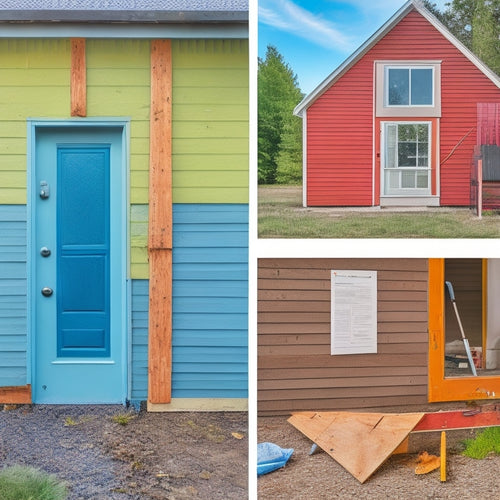
Create a Home Renovation Project Timeline in Excel
Share
You can create a detailed home renovation project timeline in Excel by setting up a tailored template with separate worksheets for tasks, materials, and budget. Define your project's scope and tasks, breaking them down into smaller components and prioritizing them based on importance and urgency. Establish a timeline framework with start and end dates, and assign task dependencies and durations. Regularly update your timeline to track progress and manage delays or setbacks. By following these steps, you'll have a solid foundation for your project, and with a few more subtle nuances, you'll be well on your way to a successful renovation.
Key Takeaways
- Define project objectives and tasks, prioritizing them based on importance and urgency to guide decision-making throughout the project.
- Organize tasks into a timeline framework with start and end dates, milestones, and dependencies to ensure a clear project schedule.
- Assign realistic task durations and allocate resources, considering labor, materials, and equipment, to maintain a realistic project timeline.
- Track progress and updates regularly, using visual indicators and status updates to identify potential issues and stay on track.
- Integrate budget planning with the timeline, allocating specific percentages of the budget to each task and visualizing budget allocation for effective tracking.
Setting Up Your Excel Template
Set up your Excel template by creating a new spreadsheet and giving it a descriptive name, such as "Home Renovation Project Timeline."
Next, organize your template by setting up different worksheets or tabs, each dedicated to a specific aspect of your project, like tasks, materials, and budget. This will help you keep your data organized and easily accessible.
Customize your template to fit your project's unique needs. Excel features like conditional formatting and data validation can help guarantee accuracy and consistency in your data entry.
Take advantage of Excel's built-in templates and themes to give your spreadsheet a professional look. You can also add custom headers and footers to include important information like your project's title, date, and page numbers.
As you set up your template, think about the specific Excel features you'll need to use. Will you need to create charts and graphs to visualize your data?
Do you need to set up formulas to calculate costs and timelines? By considering these needs upfront, you can create a template that's tailored to your project's requirements and sets you up for success.
Defining Project Scope and Tasks
You'll begin defining your project scope by identifying the objectives that will guide your renovation.
What do you want to achieve with this project, and what're your non-negotiables?
Next, you'll break down these objectives into specific tasks that need to be completed, creating a clear roadmap for your renovation.
Identify Project Objectives
Define your home renovation project's objectives by outlining the scope and tasks involved. This vital step helps you clarify your project goals and what you want to achieve.
Identify what you want to accomplish, and prioritize your objectives. Are you looking to increase your home's value, improve functionality, or enhance its aesthetic appeal? What're your non-negotiables, and what're you willing to compromise on?
Determine your project's success metrics. How will you measure the project's success? Is it by completing the project within a specific timeline, staying within budget, or achieving a certain level of quality?
Establishing clear objectives and success metrics will guide your decision-making process throughout the project. It will also help you stay focused on what's important and avoid costly mistakes.
Define Renovation Tasks
Breaking down your home renovation project into manageable tasks is essential for its success. This helps you to visualize the entire project, identify potential roadblocks, and create a realistic timeline.
Start by making a list of all the tasks required to complete your project. Be as specific as possible, and consider breaking down larger tasks into smaller, more manageable chunks.
Next, prioritize your tasks based on their importance and urgency. This will help you allocate resources effectively and guarantee that critical tasks are completed on time.
Consider using the Eisenhower Matrix to categorize tasks into four quadrants: urgent and important, important but not urgent, urgent but not important, and not urgent or important. This will help you focus on the most critical tasks first.
Remember to also consider task dependencies, as some tasks may rely on the completion of others.
Creating a Timeline Framework
You'll start creating a timeline framework by setting its boundaries, determining the start and end dates for your home renovation project.
Next, you'll establish project milestones, which are essential events that mark significant progress or completion of major tasks.
Set Timeline Boundaries
Establishing a clear timeline framework sets the stage for a successful home renovation project. To create a solid foundation, you need to define your project boundaries and timeline constraints. These boundaries will help you stay focused and guarantee that your project stays on track.
You'll want to take into account three key factors when setting your project boundaries:
| Factor | Description | Example |
|---|---|---|
| Start Date | The date when the project will begin | January 1, 2023 |
| End Date | The date when the project should be completed | June 30, 2023 |
| Budget | The maximum amount you're willing to spend | $100,000 |
Establish Project Milestones
With your project boundaries defined, you can now build a solid timeline framework by establishing project milestones. Milestones are vital as they break down your renovation project into manageable tasks, making it easier to track progress and stay on schedule.
Identify key events or tasks that mark significant accomplishments, such as completing the demolition phase, finishing the electrical work, or installing new flooring. These milestones will serve as checkpoints to assess your progress and make adjustments as needed.
Establishing milestones also allows you to celebrate your achievements along the way. Milestone celebration is important for maintaining morale and motivation throughout the renovation process. By acknowledging and celebrating your accomplishments, you'll stay focused and energized to tackle the next phase of the project.
When setting milestones, be specific and realistic. Confirm they're measurable, achievable, and align with your project goals.
You'll use these milestones to create a milestone tracking system in your Excel timeline, which will help you visualize your progress and make data-driven decisions. By establishing clear milestones, you'll be better equipped to manage your renovation project and guarantee its successful completion.
Assigning Task Dependencies and Durations
About half of your home renovation project's timeline is comprised of tasks that rely on the completion of others. These dependencies are vital to identify, as they impact your project's overall duration and resource allocation.
You'll need to determine which tasks can be done concurrently and which ones must be completed in a specific order. Start by reviewing your project milestones and identifying the tasks that depend on their completion.
Then, prioritize these tasks based on their urgency and importance. This task prioritization will help you allocate resources effectively and avoid potential bottlenecks.
Next, estimate the duration of each task, considering factors like labor, materials, and equipment. Be realistic and pad your estimates with buffers to account for unexpected delays.
Adding Start and End Dates
You've assigned task dependencies and durations, and now it's time to add start and end dates to your home renovation project timeline in Excel. This step is essential in creating a realistic project schedule.
In order to do this, you'll need to reflect on start date options. You can either set a specific start date for each task or use a dynamic start date that's based on the completion of predecessor tasks. Once you've chosen your start date option, you'll need to format your end dates accordingly. Excel offers various end date formats, such as MM/DD/YYYY or YYYY-MM-DD, so choose the one that's most intuitive for you.
When adding start and end dates, make certain to take into account any potential delays or roadblocks that may arise during the renovation process. This will help you build in buffers and guarantee a safe and successful project execution.
Tracking Progress and Updates
Your home renovation project timeline in Excel is taking shape, and now it's time to focus on tracking progress and updates. This step is vital to guarantee your project stays on track and you can identify potential issues early on.
To track progress, you'll want to set up a system to regularly update your timeline. Decide on an update frequency that works for you, such as weekly or bi-weekly, and stick to it.
Create a column in your timeline spreadsheet to track progress. You can use a simple "completed" or "in progress" status, or get more detailed with percentages or task-specific updates.
Regularly update this column to reflect the current state of each task. This will give you a clear picture of where your project stands and help you identify areas that need attention.
Managing Delays and Setbacks
Most home renovation projects encounter at least one delay or setback, and yours is likely to be no exception.
When unexpected challenges arise, it's crucial to have a plan in place to manage them effectively.
To minimize the impact of delays and setbacks, consider the following strategies:
-
Conduct thorough risk assessment to identify potential roadblocks and develop contingency planning measures
-
Establish open communication strategies to keep stakeholders informed and involved
-
Build timeline flexibility into your project schedule to accommodate unexpected changes
Integrating Budget and Resource Planning
A well-planned home renovation project relies on a delicate balance of budget and resources. You need to guarantee that you're allocating the right amount of money to each task and managing your resources efficiently to avoid cost overruns and delays.
To integrate budget and resource planning into your Excel timeline, create a separate worksheet for budget allocation and resource management. This will help you keep track of your expenses and resource utilization throughout the project.
| Task | Budget Allocation |
|---|---|
| Demolition | 10% of total budget |
| Electrical Work | 20% of total budget |
| Painting | 15% of total budget |
In this worksheet, you can list each task and allocate a specific percentage of your total budget to it. This will help you visualize your budget allocation and make adjustments as needed. By integrating budget and resource planning into your Excel timeline, you can guarantee that your home renovation project stays on track and within budget.
Visualizing Your Renovation Timeline
Now that you've integrated budget and resource planning into your Excel timeline, it's time to focus on visualizing your renovation project's progress. This step is essential in ensuring you're on track to meet your deadlines and stay within budget.
To effectively visualize your timeline, utilize Excel's built-in visual tools to create a Gantt chart or calendar view.
These features will help you:
- Identify dependencies between tasks and potential roadblocks
- Track progress against your project schedule
- Make adjustments to your timeline as needed
Frequently Asked Questions
Can I Use Google Sheets Instead of Excel for My Renovation Timeline?
You can definitely use Google Sheets for your project management needs, and it's a great alternative to Excel. Google Sheets offers similar functionality, real-time collaboration, and automatic saving, making it an excellent choice for your renovation timeline.
How Do I Handle Unexpected Changes to My Renovation Project Scope?
When scope creep hits, you'll need to reassess priorities, making budget adjustments to accommodate changes. Be prepared to negotiate with contractors, and don't hesitate to seek professional advice to guarantee your project stays on track and within budget.
Are There Any Free Excel Templates Available for Home Renovation Timelines?
You'll find plenty of free templates online to aid in renovation planning, such as Vertex42, Microsoft, and Smartsheet, offering customizable and easy-to-use templates to help you stay organized and on track with your project's timeline.
Can I Share My Renovation Timeline With Contractors and Stakeholders?
You can easily share your renovation timeline with contractors and stakeholders using collaboration tools like Excel Online or project management software, ensuring everyone's on the same page and promoting a safe, coordinated renovation process.
How Often Should I Update My Renovation Timeline to Reflect Progress?
You're the captain of a ship steering through renovation waters, and your timeline is the map. You should update it regularly, ideally weekly, to reflect progress and make adjustments, ensuring all stakeholders are on the same page and safety remains a top priority.
Conclusion
With your renovation project timeline in Excel, you're ready to roll up your sleeves and get to work! Remember, "measure twice, cut once" - and with this timeline, you've got the measurements just right. You've planned, prioritized, and prepared for every contingency. Now, it's time to execute and enjoy the fruits of your labor. Stay on track, and your dream home will become a reality sooner than you think!
Related Posts
-

Streamlining Your Exterior Renovation Timeline
To streamline your exterior renovation timeline, start by identifying your project goals and objectives, and prioriti...
-

Affordable Plastering Tools for Home Renovation Success
You're taking the first step towards a successful home renovation by investing in the right plastering tools. Start w...
-

Why Exterior Wall Renovation Requires a Plan
You're about to commence a complex and potentially costly project when you decide to renovate your exterior walls, an...


